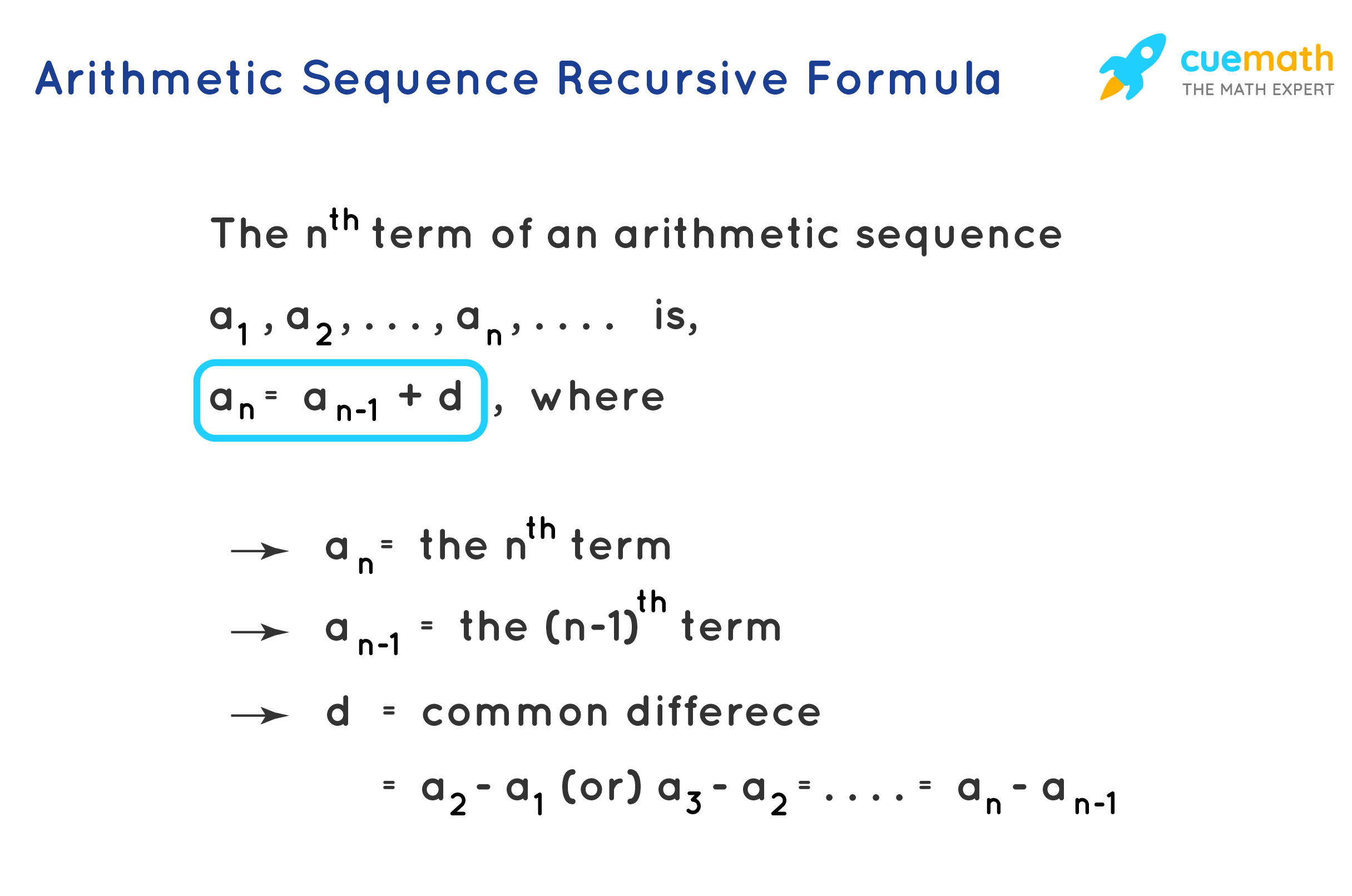Arithmetic Sequence Recursive Formula
Before going to learn the arithmetic sequence recursive formula, let us recall what is an arithmetic sequence. It is a sequence of numbers in which every successive term is obtained by adding a fixed number to its previous term. For example, -1, 1, 3, 5, ... is an arithmetic sequence as every term is obtained by adding a fixed number 2 to its previous term. This fixed number is usually known as the common difference and is denoted by d. Let us learn the arithmetic sequence recursive formula along with a few solved examples.
What Is Arithmetic Sequence Recursive Formula?
Recursion in the case of an arithmetic sequence is finding one of its terms by applying some fixed logic on its previous term. As we learned in the previous section that every term of an arithmetic sequence is obtained by adding a fixed number (known as the common difference, d) to its previous term. Thus, the arithmetic sequence recursive formula is:

Arithmetic Sequence Recursive Formula
The arithmetic sequence recursive formula is:
\(a_n=a_{n-1}+d\)
where,
- \(a_n\) = nth term of the arithmetic sequence.
- \(a_{n-1}\) = (n - 1)th term of the arithmetic sequence (which is the previous term of the nth term).
- d = The common difference (the difference between every term and its previous term).

Let us see the applications of the arithmetic sequence recursive formula in the following section.
Examples Using Arithmetic Sequence Recursive Formula
Example 1: Find the recursive formula of the arithmetic sequence 1, 5/4, 3/2, 7/4, .... using the arithmetic sequence recursive formula.
Solution:
The common difference is,
d = 5/4 - 1 (or) 3/2 - 5/4 (or) 7/4 - 3/2 = 1/4.
Thus, the recursive formula of the given arithmetic sequence is,
\(a_n=a_{n-1}+d\)
\(a_n=a_{n-1}+ \dfrac 1 4\)
Answer: \(a_n=a_{n-1}+ \dfrac 1 4\)
Example 2: Find the first 5 terms of an arithmetic sequence whose recursive formula is \(a_n = a_{n-1} - 3\) and \(a_1= -1\).
Solution:
The first term of the given arithmetic sequence is, \(a_1=-1\).
The given arithmetic sequence recursive formula is,
\(a_n = a_{n-1} - 3\)
Substitute n = 2 in the above formula, \(a_2 = a_1 - 3 = -1 -3=-4\).
Substitute n = 3 in the above formula, \(a_3 = a_2 - 3 = -4 -3=-7\).
Substitute n = 4 in the above formula, \(a_4 = a_3 - 3 = -7 -3=-10\).
Substitute n = 5 in the above formula, \(a_5 = a_4 - 3 = -10 -3=-13\).
Answer: The first 5 terms of the given arithmetic sequence are, -1, -4, -7, -10, and -13.
Example 3: Find the recursive formula of the arithmetic sequence -7, -13/2, -6, -11/2, .... using the arithmetic sequence recursive formula.
Solution:
The common difference is,
d = -13/2 - (-7) (or) -6 - (-13/2) (or) -11/2 - (-6) = 1/2.
Thus, the recursive formula of the given arithmetic sequence is,
\(a_n=a_{n-1}+d\)
\(a_n=a_{n-1}+ \dfrac 1 2\)
Answer: \(a_n=a_{n-1}+ \dfrac 1 2\)
FAQs on Arithmetic Sequence Recursive Formula
What Is Arithmetic Sequence Recursive Formula?
The arithmetic sequence recursive formula is used to find a term of an arithmetic sequence by adding its previous term and the common difference. By this formula the nth term of an arithmetic sequence a\(_1\), a\(_2\), a\(_3\), ... whose common difference is 'd' is, \(a_n=a_{n-1}+d\).
How To Derive Arithmetic Sequence Recursive Formula?
We know that the difference (common difference, d) between every two successive terms of an arithmetic sequence is always constant. i.e., any term (nth term) of an arithmetic sequence is obtained by adding the common difference (d) to its previous term ((n - 1)th term). i.e., the recursive formula of the given arithmetic sequence is, \(a_n=a_{n-1}+d\).
What Is the Use of Arithmetic Sequence Recursive Formula?
The arithmetic sequence recursive formula is used to find any term of an arithmetic sequence without actually knowing the first term of the sequence. By this formula, \(a_n=a_{n-1}+d\), where \(a_n\) is the nth term , \(a_{n-1}\) is the (n - 1)th term, and d is the common difference (the difference between every term and its previous term).
What Is the nth Term of the Sequence -4, 2, 8, 16, ... Using Arithmetic Sequence Recursive Formula?
The common difference of the given sequence is,
d = 2 - (-4) (or) 8 - 2 (or) 16 - 8 = ... = 6.
By arithmetic sequence recursive formula, the nth term is,
\(a_n=a_{n-1}+d\)
\(a_n=a_{n-1}+8\)
visual curriculum
